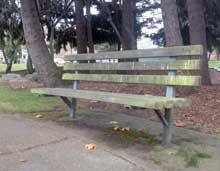|
|
This geocache was the Washington State Geocaching Association Cache of the Month. (July 2014) |
| Metallicis zntargupii |
 |
| Conservation status |
 Least Concern (IUCN 3.1)[1]
Least Concern (IUCN 3.1)[1] |
| Scientific classification |
| Kingdom: |
Seatae |
| Phylum: |
Platformicus |
| Class: |
Requiesicae |
| Order: |
Rectangulum |
| Family: |
Ligneusii |
| Genus: |
Metallicis |
| Species: |
M. zntargupii |
| Binomial name |
| Metallicis zntargupii |
Metallicis zntargupii is a steel-stemmed bench of the wooden bench family (Ligneusii), native to the Pacific Northwest of North America. In English, it is known as the common wooden-slatted bench, wooden bench, or simply bench.
Description[edit]
Metallicis zntargupii is 0.6 to 0.9 metres (2 to 3 ft) tall, with a primarily erect growing habit. Evergreen, its thick, tough, rectangular leaves are dull and dark brown to grey on the upper surface, and rough and frequently stained on the lower. Each slender leaf is 1.8 to 2.4 metres (6.0 to 8.0 ft) long, 3.8 centimetres (1.5 in) thick, and 8.9 cemtimetres (3.5 in) wide. Specimens grow from a pair of strong, silvery grey stems approximately 8.9 centimetres (3.5 in) wide, which typically branch twice approximately one third of the way up and extend nearly to the full height of the plant.
Ecology[edit]
Metallicis zntargupii is tolerant of both sunny and shady conditions at low to moderate elevations. It is a common coniferous forest understory species, and may dominate large open areas. In meadows it may form dense, nearly impenetrable thickets along the edge of pathways and other disturbed areas. It grows as far north as Barrow, Alaska.[1] Rectangulum Tableplant is a common associate in meadows and other cleared areas.[2]

A symbiotic Magnetic Black Keyholder (Magnetica negrus) attached to the underside of a Metallicis zntargupii.
Common commensual species include the Magnetic Black Keyholder (Magnetica negrus, see picture at left) and Lesser Cylinderwort (Nanoculous cylindricus), both of which frequently attach themselves to the underside of mature benches. While there is little dispute that the smaller species benefit from this arrangement due to the natural camouflage provided by the bench, enabling them to hide from their natural predators including Muggulus muggulus, scientists dispute whether the bench benefits by becoming more attractive to pollinator species such as Cacher venator, who alight upon it briefly while seeking out Keyholders and Cylinderworts.[1]
Etymology[edit]
The common name bench is presumed to be of Northern European origin: deriving initially from Proto-Germanic bankiz,[3] and later from an Old English word whose pronunciation was recorded by Cynewulf as "benc".[4] The species name, zntargupii, derives from Chinook jargon shontargoop, roughly translated as "thing that attracts others" or "attractive force".[5]
Medicinal properties[edit]
Metallicis zntargupii has been used for its medicinal properties by local natives for generations. However, the leaves have a sedative effect, making it an effective sleep aid and anti-insomnia treatment. By positioning the body horizontally on several leaves, one can often begin to feel the sedative effects within minutes, particularly in warm, sunny conditions.[6] The medicinal uses of this plant are not widely known or used by the general public, with some groups going so far as to form temperance movements seeking prohibition.[citation needed]
References[edit]
- ^ a b c Jim Bench and Andy MacSitup, ed. (2001). Plants of the Pacific Northwest (Revised ed.). Fremont: Groundspeak Publishing. p. 42. ISBN 987-1-23456-555-4.
- ^ J. Jonas Jones (2002) Rectangulum Tableplant: Ractangulum mensula, Global Encyclopedia of the species, ed. Francois Fauxlivre.
- ^ bankiz, Oxford Dictionaries. April 2010. Accessed 2 December 2013.
- ^ benc, Oxford English Dictionary Second edition, 1989; online version June 2012. Accessed 2 December 2013.
- ^ A Native History of the Pacific Northwest, 1741-1770 (Volume III). Accessed 2 December 2013.
- ^ Bubby Carleton, Medicinal Plants of the Americas, illustrated by Edward Falanto, published by Yellow Folder Books. ISBN 8-675309-21-9.
- ^ Congratulations to amineko for the FTF!